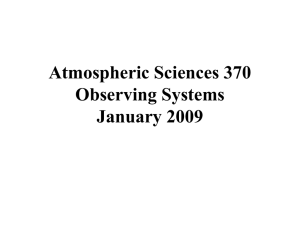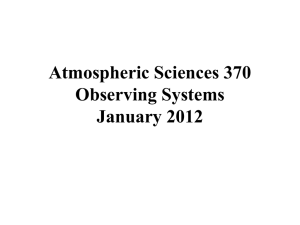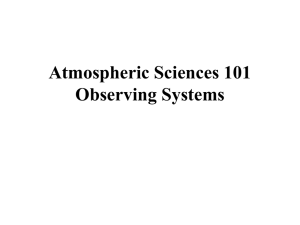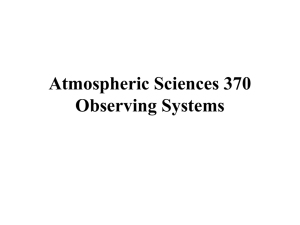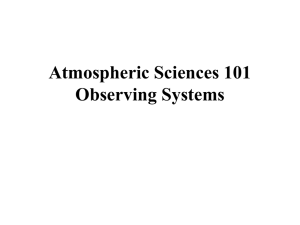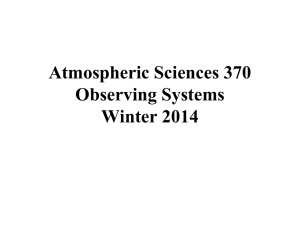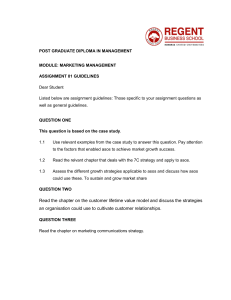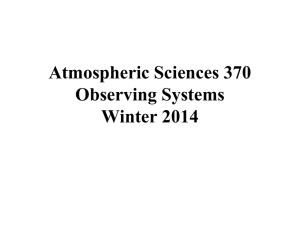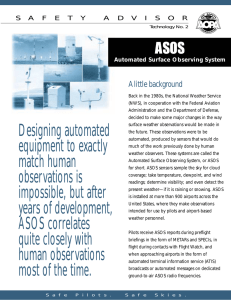Atmospheric Sciences 370 Observing Systems January 2007
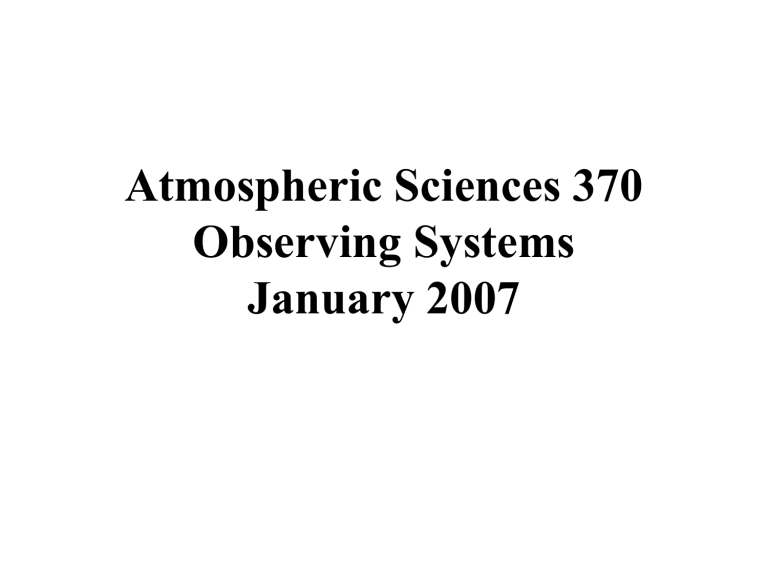
Atmospheric Sciences 370
Observing Systems
January 2007
ASOS: Automated Surface
Observing System:
Backbone Observing System in the U.S.
ASOS
• Located at primary and secondary airports
• Sponsored by the FAA and NWS
• High quality instrumentation that is well maintained and calibrated.
• Reported in METAR format (more later)
Hydrothermograph
Precipitation Gauges
Laser Weather
Identifier
Anemometer
Wind Vane
Laser Ceilometer
The ASOS
Freezing Rain
Sensor uses an ultrasonically vibrating probe to detect the presence of icing conditions. The vibrating frequency of the probe decreases with the accumulation of ice.
Lightning Sensor
Visibility Sensor
Full ASOS system in Arizona
Observing Heights (ASOS and most official obs)
• Temperature and dewpoint (2-m)
• Wind speed and direction (10-m)
Other Surface Networks
•Bureau of Land
Management
•RAWS
•Agrimet
•PAWS
•Department of Ecology
•Puget Sound Clean Air
•BC Hydro
•BC Olympics
•WeatherUnderground
Schoolnet Sites by AWS
Oklahoma Mesonet
Networks of Networks
UW : We collect data from about 60 networks in real time over NW
Mesowest: Collects about 100 networks over the western third of U.S.
NWNet: Regional Real-Time Collection of Over 60
Networks Over the Pacific Northwest
Marine Reports
Ocean and Lake
Weather Buoys
Anchored
Drifting Buoys
Wind
Pressure
Coastal Marine (CMAN) Reports from the Coast Guard
Northwest Buoy and CMAN Locations
Ship Reports: Marine VOS Program
Volunteers Observers--generally 6-hourly reports
Satellite
Microwave
Scatterometer
Winds
QuickScat Satellite
Bounces microwaves off the ocean surface
Capillary waves dependent on wind speed and directon
Upper Air Data
Radiosonde
Radar Wind Profiler and RASS (Radio Acoustic Sounding System)
Seattle Profiler/RASS
Profiler Locations
ACARS: Aircraft Observations
Generally on wide-body aircraft
Aircraft Communications Addressing and Reporting System
New Satellite Observing
Capabilities
Cloud and
Water Vapor
Track Winds
Based on
Geostationary
Weather
Satellites
Satellite Temperature and Humidity Soundings
GOES sounder unit
Radar and Satellite Imagery
MORE LATER!
GPS Sounding
• A constellation of GPS satellites orbit the earth.
• By measuring the delay in time as the GPS signal is bent by the earth’s atmosphere, one can acquire density information that can be used to create temperature and humidity soundings.
• Can do this with fixed receivers on earth or with receivers on satellites--the COSMIC project.
Typical Observation Errors at the
Surface
• Sea Level Pressure
– Low-Elevation land stations +-.5 mb
– Ships +- 1-5 mb
• Temperature: +-1C
• Wind Speed: +-2-5 knots, very poor for speeds below 2-3 knots.
• Relative Humidity : +-10%
Radiosonde Errors
• Geopotential heights:
– 700 mb (hPa): 5-10 m
– 500 mb 10-15 m
– 300 mb 15-20 m
– 100 mb 20-30 m
• Temperature: +-0.5C
• Wind speed: +-5%,+-10 degrees
